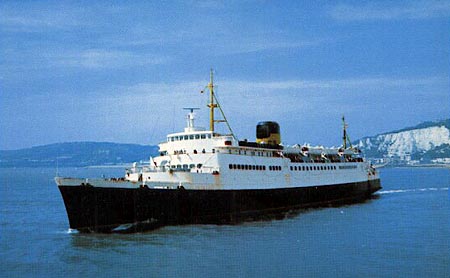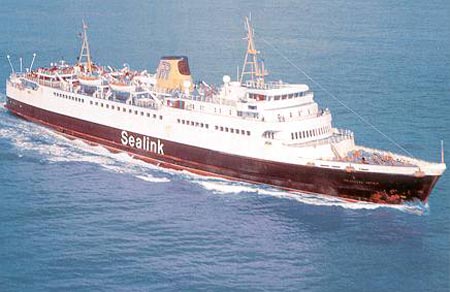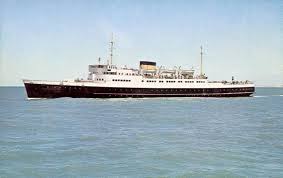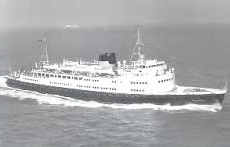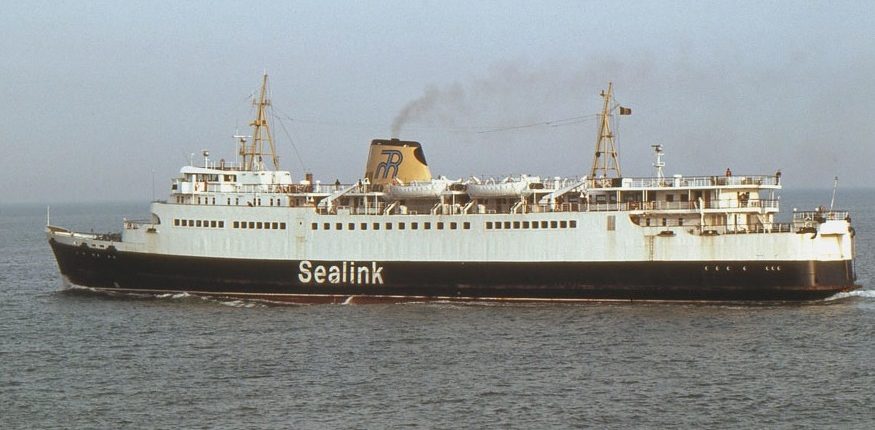
RMT (Regie voor Maritiem Transport)
Regie voor Maritiem Transport (RMT) was owned by the Belgian Government from the outset in 1846, operating passenger and mail services from Oostende and Zeebrugge in conjunction with British Railway Companies using mainly Kentish ports.
During the peak summer service a Ostend-Folkestone service was initiated in 1968 and also from May 29th, a service was started to Parkeston Quay for the conveyance of light commercial and passenger traffic.
Co-operation with Sealink ended in 1986. The main similarity to the earlier Belgian car ferries was the low headroom vehicle deck which precluded the carriage of freight. Bow doors were also omitted, therefore adding to turn around times.
On 28 February 1997 the Belgian State closed an important and historical period concerning transport of passengers from and to the UK. The first official crossing ever under the Belgian State took place in 1846, a history spanning 151 years.
Harwich P.Q. to Ostend 1968-1973
Artevelde
- Built. 1958 (IMO 5025586)
- Yard. Cockerels of Hoboken
- Class of Ship. Passenger
- Operator. RMT
- Route. Harwich- Ostend
- Length. 116.85 m
- Passengers. 1000
- Freight Capacity. 160 cars, 7 coaches
- Speed. 21 Knots
- Status. Sunk 19/02/1996
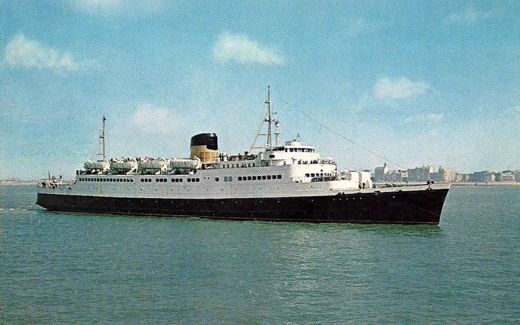
Artevelde
MV Artevelde was launched and delivered to the Belgian Maritime Transport Authority in 1958, immediately commencing service between Ostend and Dover. In November 1967 she suffered a collision against the Danish motor vessel Alameda during thick fog conditions, suffering heavy damage in the fore section. After one month, she retook service in the route Ostend-Dover. In October 1970 she rammed and sank the 200-ton coaster ship Seacon; damage took six weeks to repair. In August 1974 she collided with a ramp at Dover Eastern Docks, temporarily rendering it unusable.
In 1976 she was sold to a Greek businessman, being renamed Aigaion and commencing service on a number different routes, which started on Piraeus and went along several of the numerous isles on the Aegean Sea. In 1983 she ran aground near Paros, suffering the flooding of the engine room. In 1993 she was retired from service and laid up. Intended to be rebuilt as a cruising ship named Kallisti, during the reconstruction works effectuated in Piraeus in February 1996 she caught fire and was towed from the dock to the Island of Atalanti, being the ship mysteriously sank while in route.
Koningin Fabiola
- Built. 1962 (IMO 5192963)
- Yard. Boelwerf Vlaanderen
- Class of Ship. Passenger
- Operator. RMT
- Route. Harwich- Ostend 1968-1973
- Length. 117 m
- Gross Tonnage. 4727
- Passengers. 850
- Speed. 20 Knots
- Status. Scrapped 2004
The Koningin Fabiola was built in 1961/62 by Boel Yard Temse as built number 1391, with a capacity for 900 passengers and 160 cars. The launch took place on the 20th November 1961 and trials were held on the 7th June 1962. The vessel came into service on the 10th June 1962.
The ship had two restaurants, one self-service and one buffet at the disposal of the passengers.
Her last crossing for Oostende – Dover was on the 15 June 1983. After that she was docked in the zeewezendok until she was sold to the Ionian Navigation Co Ltd Valetta Malta and was given the new name “Olympia”.
Sometime later in 1985 the Olympia was chartered by Hellenic Mediterranean Lines and renamed “Lydia”. In 1992 she was sailing between Ortona and Igoumenitsa.
In 1993 the KF was sold again to Lefki Investment Corp Kingstown St Vincent and renamed “Ephesus” where she was performing services between Brindisi and Valona.
Sometime later the ship was chartered by Topas Maritime lines and was sailing between Bari-Igoumenitsa-Cesme.
In 1996 she was confiscated in Bari to be sold later to Skylark Trading Ltd St Vincent and renamed again to “Bergame” to sail between Bari and Cesme.
After a few changes of owners and charters the ex Koningin Fabiola arrived in 1998 with Anatolia Ferries under her new name”Bosphorus”.
After years of service Koningin Fabiola arrived in Aliaga Turkey to be scrapped in 2004.
Princesse Astrid
- Built. 1968 (IMO 5607310)
- Yard. N.V Boelwerf
- Class of Ship. Passenger
- Operator. RMT
- Route. Harwich- Ostend 1968-1973
- Length. 117m
- Gross Tonnage. 188
- Passengers. 1800
- Speed. 19 Knots
- Status. Scrapped 1999
One of the second pair of Boel series launched for R.M.T., the Belgian partner of Sealink consortium. Purchased from R.M.T. for which she served the ports of Dover and Harwich.
In 1983, was first employed on the line Bari – Corfu – Igoumenitsa – Patras under Ventouris Ferries’s colours, then, from 1988, was moved to Rafina – Andros – Tinos – Myconos line.
In 1997 was sold to Agapitos Express Ferries and put on the route Piraeus – Syros – Paros – Naxos, Heraklia – Schinousses – Koufonissia – Amorgos – Astypalea. In November 1999 was sold to Minoan Flying Dolphins; first routed on the same services performed under Agapitos ownership, after her arrest of October 2000 was never fully employed on Hellas Ferries services, being laid up from 2002. In September 2003 was sold for scrap, sailing for her last trip to Alang, India, with the name “Express Erme”.
Prinses Josephine-Charlotte II
- Built. 1949 (IMO 5285356)
- Yard. Cockerels of Hoboken
- Class of Ship. Passenger
- Operator. RMT
- Route. Harwich- Ostend
- Length. 373 ft.
- Gross Tonnage. 2572
- Passengers. 700
- Speed. 22 Knots
- Status. Scrapped 1984
After the fall of Belgium and France in June 1940, vessels of RMT were taken into the Royal Navy for use in the landing ship infantry role. These included the steamers Prince Charles , Prince Leopold , Princesse Astrid, Princesse Josephine Charlotte, Prince Baudouin, Prins Albert, and Prince Philippe .
The vessel had a total length of 113.65 meter and was driven by 2 7600 HP Sulzer engines. It could carry 700 passengers and 100 cars. Her maiden trip was on the 3th July 1949 and was renamed “Prinses Josephine Charlotte” in May 1952.
As from May 1969 until September 1973 the Prinses Josephine Charlotte performed service from Ostend to Harwich.
Prinses Josephine Charlotte was sold to Blance Compania Naviera company Panama and renamed “Leto”. Later in 1977 it was sold to Kousouniadis Piraeus Greece and renamed Athens Express.
Eventually the Prinses Josephine Charlotte was taken out of service in 1984 and layed by in the Eleusis Bay Greece. It was scrapped in 1985.
Roi Baudouin
-
- Built. 1965 (IMO 6510851)
- Yard. Cockeril
- Class of Ship. Passenger Ferry
- Operator. RMT
- Route. Harwich- Ostend 1969-1973
- Length. 117,84 m
- Gross Tonnage. 3241
- Passengers. 850
- Speed. 21 Knots
- Status. Scrapped 26/03/2009
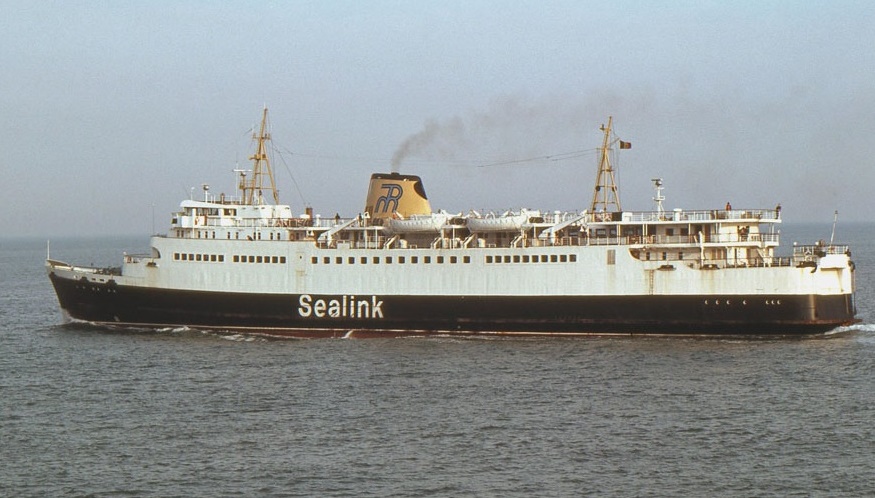
Roi Baudouin
Roi Baudouin was launched on 13th February 1965 and,and handed over to the owners on the 2nd of July and brought into service on the 5th of July.
On the 29th May 1968 Roi Baudouin berthed at Parkeston Quay opening the new link with Ostend, the service was daily, leaving Parkeston Quay at 21.45 in the summer and 22.30 in the winter months, at 3241 tons, accommodation was for 850 passengers and 160 cars.
Roi Baudouin, set sail on Monday, 23 March, under tow to Aliaga in Turkey for scrap.
The ship had been laid up pretty much since 1995 when Ventouris Sea Lines went bankrupt. She was brought back into service in 1999 and 2000 but was laid up again, latterly in Elefsis, in 2001.
The career end of the Roi Baudouin when the Greek Bank confiscated the ship in 1995 and docked it in Piraeus. Aghios Georgeos Ferries used the ship for a few years and it was sold for scrap in 2003.
Roi Leopold (III)
- Built. 1955 (IMO 5298808)
- Yard. Cockeril
- Class of Ship. Passenger Ferry
- Operator. RMT
- Route. Harwich- Ostend 1969
- Length. 114 m
- Gross Tonnage. 3388
- Passengers. 1700
- Speed. 22 Knots
- Status. Scrapped 19/03/1987
On Wednesday the 9th November 1955, Roi Leopold III was launched at Hoboken. with a capacity of 1700 pax and five decks the ship was handed over on the 22th June 1956 and came into service in July 1956. It had two restaurants, a dining area and four others lounges. There were 18 cabins and 104 beds. Thirty cars could be placed on the aft deck.
The Roi Leopold III was taken out of regular service in 1975 and used for special trips. Later in 1976 placed as reserve vessel.
On the 2nd March 1978 the ship was sold to Taif Compania Naviera Panama and left Ostend on the 10th to Piraeus Greece to be converted as a car-ferry. It was renamed Najd. It came into service on the Jeddah-Aquaba-Port Suez line.
In 1986 the ship was renamed “Najd I” but the next year as from 15th March 1987 it was scrapped by the Gadani Beach by World Marine Shipping & Trading C° in Pakistan.
On the 10th September 1973 Roi Baudouin sailed from Parkeston Quay for the last time and closed down this short lived service.
We are adding more information to this site on a regular basis, if you wish to submit any photos or provide any information, then please use the contact page at the bottom of the screen.
Copyright Ownership.
We attempted to get the consent of copyright holders to use this material for nearly all of the photographs on the website.
In the few cases where names are available, a thorough search was made using telephone directories, photographic copyright directories, People Search and Google Area Search. None of the copyright owners could be traced in this way and we believe we have exhausted all reasonable avenues.
The consensus opinion of these authorities was that if any two of the following situations applied we would be deemed to have taken sufficient action to avoid infringing copyright laws:
- Reasonable efforts made to contact the copyright holder
- No financial gain will be made in relation to the photos
- A letter is obtained from present owner of photos
- There is a proviso included stating that if offence is caused document will be removed
The website owner undertakes to remove any photograph from the website where offence is caused. All the above conditions have therefore been met.
← SMZ (Stoomvaart Maatschappij “Zeeland) Other Shipping Lines →